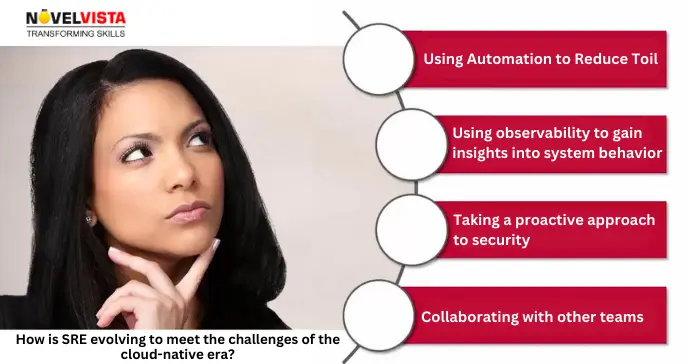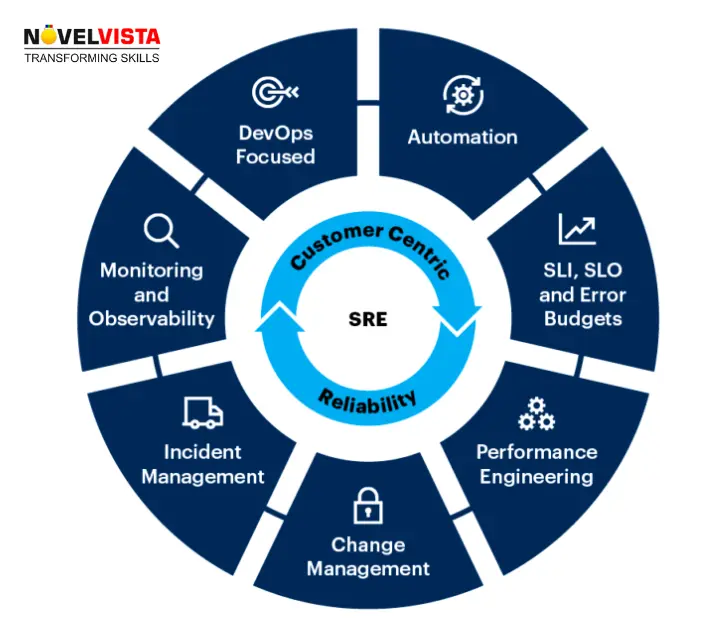Cloud-native technologies, such as containers and microservices, have revolutionized the way applications are developed, deployed, and managed. The numbers speak for themselves:
The cloud-native era has brought about a number of challenges for SRE teams. These challenges include:
In order to meet these challenges, SRE teams are evolving their practices. Some of the key trends in the future of SRE include:

Here are some specific examples of how SRE teams are evolving to meet the challenges of the cloud-native era:
Toil is the repetitive, manual work that is necessary to keep a system running but does not add value. Toil can be a drain on SRE teams' time and energy, and it can prevent them from focusing on more strategic work.
Automation can be used to reduce toil byautomating repetitive tasks, such as:
Automation can free up SRE teams tofocus on more strategic work, such as:
Automation is becoming central to SRE operations. By automating repetitive tasks, SREs can save time, reduce human errors, and focus on strategic initiatives. According to asurvey byAtlassian,61% of IT professionals say automation will be a high or extremely high priority for their organization in the next 12 months.
Observability is the practice of collecting and analyzing data from a variety of sources, such as logs, metrics, and traces, to gain insights into system performance, reliability, and availability.This data can be used to identify patterns and anomalies, which can help engineers to understand how their systems are behaving and to identify potential problems.
For example, if an SRE team is monitoring a web application, they might use observability tools to collect data on the number of requests per second, the average response time, and the number of errors. This data can be used to identify patterns, such as a sudden increase in the number of errors or a decrease in the average response time. These patterns can then be used to identify potential problems, such as a bottleneck in the application or a problem with the underlying infrastructure.
Observability is a powerful tool that can help SRE teams to gain insights into system behavior and toidentify potential problems.However, it is important to note that observability is not a silver bullet. It is still necessary for engineers to have a deep understanding of their systems in order to interpret the data and to take corrective action.
Overall, observability is a powerful tool that can help SRE teams to gain insights into system behavior and to improve the reliability of their systems.
Security is an important aspect of SRE, and it is important to take a proactive approach to security. This means that SRE teams should not wait for security problems to happen before they take action. Instead, they should be proactive in identifying and mitigating security risks.
There are a number of ways to take a proactive approach to security. Some of these include:
By taking a proactive approach to security, SRE teams can help to protect their systems from attack and ensure that their users' data is safe.
Service mesh technologies, like Istio and Linkerd, are gaining traction as they provide better visibility, security, and reliability for microservices. A survey by the Cloud Native Computing Foundation found that 24% of respondents were using service mesh in production environments.
SRE teams are collaborating more closely with other teams, such as development, security, and product management. This helps them to ensure that reliability is considered from the earliest stages of the development process.
Collaboration with other teams can help SRE teams to:
For example,SRE teams can work with development teams to ensure that new features are designed in a way that is reliable. They can also work with security teams to ensure that systems are secure from the start. SREs are actively embracing DevOps principles to ensure smooth development, deployment, and ongoing maintenance.

The future of SRE is bright. As the cloud-native era continues to evolve, SRE teams will play an increasingly important role in ensuring the reliability of software systems. SRE teams will need to continue to evolve their practices in order to meet the challenges of the future. However, the principles of SRE, such as automation, observability, and collaboration, will remain essential.
To advance in your SRE career, also take a look at ourSRE interview questionsblog, which will assist you in acing your interview.
Here are some statistics that illustrate the growing importance of SRE:
These statistics show that SRE is a growing field with a bright future. If you are interested in a career in SRE, Please get certified inSRE Foundation&SRE Practitionernow is a great time to get started.
🎯 Master the future of reliability with the SRE Foundation Course.
In conclusion, the future of Site Reliability Engineeringis firmly entwined with the cloud-native era. As organizations increasingly adopt cloud-native technologies, SREs face unique challenges to ensure the reliability and performance of complex systems. By leveraging automation, embracing DevOps practices, and harnessing the power of AI and ML, SREs are well-positioned to meet these challenges head-on.As the landscape continues to evolve, SREs must remain adaptable, innovative, and data-driven to deliver outstanding reliability and user experience in the cloud-native world.
Confused about our certifications?
Let Our Advisor Guide You